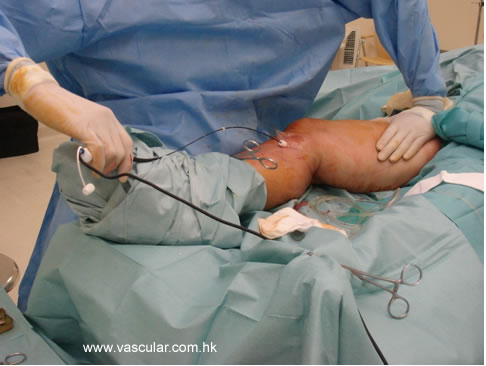Blood Circulation
Heart pumps oxygen-rich blood through a network of arteries to provide the needed nutrient and oxygen to all body parts. Veins return blood from body tissue to be enriched with oxygen again and repumped by the heart.
.gif)
What are spider veins?
There are three types of abnormal veins, which are frequently seen in combination. “spider veins” (telangiectasias) are the fine red capillary veins in the dermis. The larger blue veins are called “reticular veins”, and are slightly deeper below the skin’s surface. Varicose veins are the largest of the abnormal superficial veins, and bulge above the skin’s surface.
.jpg)
What are the treatments for spider vein?
Backflow from larger veins into smaller capillaries causes their distension and the formation of spider veins. Underlying varicose veins should be treated before treating the spider veins.
Sclerotherapy is the treatment for the small reticular veins and spider veins. Using very fine needle the veins are injected with sclerosant that irritates the inner lining, causes mild inflammation, obliteration, and subsequent reabsorption of the unwanted veins. The treated veins will fade as the body gradually removes them.
.jpg)
What are varicose veins?
Veins become congested with blood resulting in spider veins or varicose veins. Spider veins are small red, blue or purple veins on the surface of the skin. Varicose veins are larger, bulging, and tortuous veins that are located somewhat deeper than the spider veins
What causes varicose vein?
Hereditary is the number one contributing factor. Hormonal factors include pregnancy. Other predisposing factors are standing occupations, obesity and heavy weight lifting.
How are varicose veins diagnosed?
Accurate identification of the origin of back flow (reflux) is a prerequisite for the planning of any intervention. Varicose vein is diagnosed primarily by physical examination. The usual pattern of distribution are the
- great saphenous vein
- small saphenous vein
- incompetent perforating veins.
Reflux often can be deduced by physical examination and confirmed by Doppler examination. Duplex scan is required to precisely pinpoint the origin of reflux.
"Duplex scan" detects leaking valves, direction of blood flow and evidence of previous blood clots. It also provides a map of the affected veins and their connection.
What you can do?
You can’t do anything about your heredity, age, or gender. However, you can help delay the development of varicose veins or keep them from progressing.
Conservative management of venous diseases
- Avoid over-weight
- Avoid obstructing the veins. Do not wear tight socks, girdles or garters
- Avoid high-heel shoes as it prevent calf muscle contraction
- Avoid prolonged standing or sitting still. Change posture, flex your feet or tip toes 2-3 times every few minutes to contract the calf muscle pump
- Avoid crossing legs while sitting
- Patient with severe symptom, benefit from leg elevation above the level of heart for 1/2 hour, three times daily. Leg elevation through-out the night for patient with significant edema
- Wear correctly fitted graduated compression elastic stocking. Replace when they become loose-fitting
- See a surgeon who can diagnose the cause of your varicose veins, the sources of venous reflux in your legs, and offer a variety of treatment options
.jpg)
What are the treatment options?
Early treatment prevents advance complications such as eczema and non-healing ulcer. The extent and distribution of the disease are crucial in choosing the treatment options. Feel free to discuss the benefits and side effects with a vascular surgeon.
-
Stockings are effective in controlling symptoms but are only effective if worn regularly. In hot environments, the use of elastic stockings may be impractical.
-
Outpatient injection of smaller veins such as spider veins and reticular veins offers the best results in limbs with localized areas of reflux. Sclerosant in the form of microfoam is more effective for large varicosity.
-
Ambulatory phlebectomy can be performed under local anesthesia. Varicose veins are removed with hooks through small skin puncture. Recovery is brief and uneventful
- The great saphenous is the largest superficial vein along the inner thigh and calf and generally receives the most varicose veins. Surgery is the traditional way of treating varicose vein involving the great saphenous vein system.
- Through a small groin incision the origin of back flow of blood is tied off (a procedure called high ligation
- The channel of reflux is removed (stripped )
- Multiple fine incisions are made to fish out the branch varicosity (hook phlebectomy)
Open Surgery
Performed under local or general anaesthesia
- High tie: A small groin crease incision is made to cut and tie off the origin of reflux at the junction between the superficial and deep vein
- Invagination stripping: A “PIN stripper” is inserted through the cut end and advanced down the vein. The end of the PIN stripperis sewn to the end of the vein. The tip of the stripper is perforated through the skin at knee level and the stripper is removed. The vein is pulled in on itself and is “stripped” out through a 2mm incision
.jpg)
- Hook Phlebectomy: through multiple small stab incisions a hook is inserted to fish out and remove the vein
.jpg)
Endovenous Laser Therapy (EVLT)
.jpg)
The skin is numbed, under ultrasound guidance, a catheter is inserted through a needle stick into the abnormal vein.
.jpg) Catheter is directed to the origin of reflux
Catheter is directed to the origin of reflux
.jpg)
.jpg) Laser energy is delivered causing the vein to collapse and seal shut.
Laser energy is delivered causing the vein to collapse and seal shut.
Endovenous RFA
Similar to EVLT but radiofrequency energy is used

|